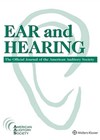
Journal Reviews
Sudden sensorineural hearing loss – who will get better?
Idiopathic sudden sensorineural hearing loss (ISSNHL) is a rare but potentially devastating condition. For patients presenting with this condition, prognosis is of paramount importance. Wu et al begin to address this issue by retrospectively studying 17 potential prognostic factors for...
What is trendy?
This edition of Seminars in Hearing focused on the results from the MarkeTrak 2022. Now, the relevance to the UK market might be slight limited with some of the data but there are certainly a few interesting nuggets for our...
An understandable backup
This small study comparing the auditory temporal processing of seven younger adults with that of seven older adults does not show anything breathtakingly new in its conclusions. After the assessment to rule out compounding factors such as middle ear pathology,...
It is all so COSI…
Something which we have realised for a long time in the UK is the importance of the clinician in the assessment and long-term adoption of hearing aids. This common sense article outlines the need for more individualised patient pathways, thinking...
Low-frequency air-bone gaps appear to be a true audiological finding in Ménière’s disease
There is a lack of established objective tests in Ménière’s disease (MD) that can provide information about the disease process. The appearance of low-frequency air-bone gaps (LFABGs) in MD is a recognised but unexplored phenomenon. Two theories have been suggested...
Small but significant
These authors try to circumnavigate the conundrum of what is influenced by what. For something so small, the impact of the Stria Vascularis cannot be understated. The difficulty in reviewing the influence of loop diuretics or aminoglycosides on the Stria...
Is there an association with cognitive impairment and hearing loss in a developing country?
Hearing loss (HL) is the third leading chronic health condition among older adults. Most studies investigating HL and cognition have been performed in high-income countries. Risk factors for dementia (eg. hypertension, midlife hearing loss, obesity and physical inactivity) are more...
A twitch in time with a flicker of knowledge
The middle ear muscles can be seen as one of the ear’s safety mechanisms, and the interplay between eyes and ears has been established; think vestibular ocular reflex (VOR) or semi-circular canal dehiscence (SCCD). But can this protective mechanism be...
Inner ear immunity
There is much speculation regarding the ear’s immune response. The environment in which we live and breathe is getting ever more complex; aspects such as the percentage of the population with autoimmune conditions are on the rise and, therefore, it...
How do mermaids hear?
When the imagery of childhood fairy tales meets the more clinically analytical mind of an adult, there may at some point come the question, ‘how do mermaids hear’? Luckily a department of biology in Denmark has sought to furnish such...
Continuous Ambulatory Vestibular Assessment (CAVA)
This article presents initial test findings using a novel system called CAVA - Continuous Ambulatory Vestibular Assessment. Akin to the 24-hour ECG tape to identify cardiac arrhythmias, this system aims to continuously monitor the presence of a nystagmus pattern in...
Do personal listening devices cause cochlear synaptopathy?
Cochlear synaptopathy is a condition in which noise interrupts the synaptic communication between sensory inner hair cells and low spontaneous rate cochlear nerve fibres. Since these nerve fibres are associated with signal coding in noisy backgrounds, their disruption leads to...















